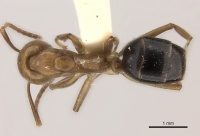Dolichoderus diversus
| Dolichoderus diversus | |
|---|---|

| |
| Scientific classification | |
| Kingdom: | Animalia |
| Phylum: | Arthropoda |
| Class: | Insecta |
| Order: | Hymenoptera |
| Family: | Formicidae |
| Subfamily: | Dolichoderinae |
| Tribe: | Dolichoderini |
| Genus: | Dolichoderus |
| Species: | D. diversus |
| Binomial name | |
| Dolichoderus diversus Emery, 1894 | |
| Synonyms | |
| |
Identification
Color red brown with dark gaster; scapes and mesosomal dorsum with abundant delicate erect setae; dorsal and posterior faces of propodeum meeting at angle but not produced as a projecting flange; face and mesosomal dorsum sublucid; anterodorsal pronotum long and tapering, with no development of humeri.
This species is like a hairy version of Dolichoderus lutosus (Jack Longino).
Distribution
Latitudinal Distribution Pattern
Latitudinal Range: 21.216944° to -19.66666667°.
| North Temperate |
North Subtropical |
Tropical | South Subtropical |
South Temperate |
- Source: AntMaps
Distribution based on Regional Taxon Lists
Neotropical Region: Brazil, Colombia (type locality), Costa Rica, Ecuador, French Guiana, Guyana, Mexico, Panama, Trinidad and Tobago, Venezuela.
Distribution based on AntMaps
Distribution based on AntWeb specimens
Check data from AntWeb
Countries Occupied
| Number of countries occupied by this species based on AntWiki Regional Taxon Lists. In general, fewer countries occupied indicates a narrower range, while more countries indicates a more widespread species. |

|
Estimated Abundance
| Relative abundance based on number of AntMaps records per species (this species within the purple bar). Fewer records (to the left) indicates a less abundant/encountered species while more records (to the right) indicates more abundant/encountered species. |

|
Biology
MacKay (1993): Little is known of this common species. Nests are usually found in hollow twigs, up to 800 meters in elevation. It commonly occurs in disturbed habitats and is often imported into the United States on banana debris and on orchids. Workers rapidly escape when the nest is opened. This species nests together with stingless bees (Harada, pers. comm.) and with Camponotus sp. in mangrove swamps. Loose sexuals have been collected in Feb. (Guatemala, Guiana), April (Panama, Peru), May (Mexico), June (Guiana), Sept. and Nov. (Brasil).
In Costa Rica, I know this species from one stray worker I collected at San Pedrillo in Corcovado National Park. However, the types of Dolichoderus championi, a junior synonym of D. diversus, were collected by Tonduz in Costa Rica. I twice collected the species in the Santa Marta area of Colombia, once in a 9mm diameter dead stem, and once in a 10mm diameter live stem of a Brosimum(?) with large, pink scale insects on the interior walls (Jack Longino).
Castes
Worker
Images from AntWeb
  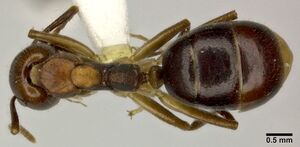 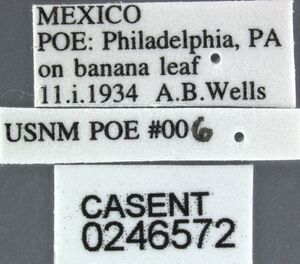
| |
| Worker. Specimen code casent0246572. Photographer Andrea Walker, uploaded by California Academy of Sciences. | Owned by USNM, Washington, DC, USA. |
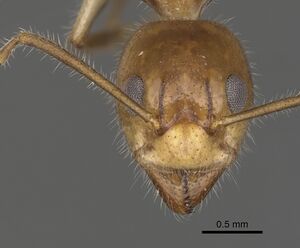 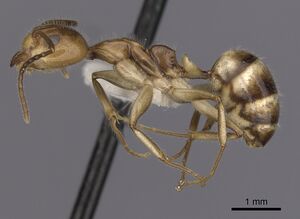  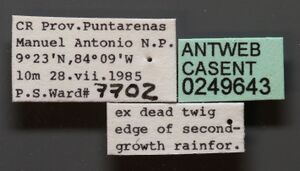
| |
| Worker. Specimen code casent0249643. Photographer Will Ericson, uploaded by California Academy of Sciences. | Owned by PSWC, Philip S. Ward Collection. |
  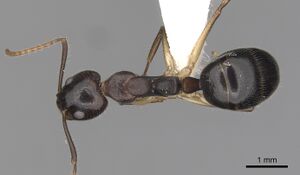 
| |
| Worker. Specimen code casent0249644. Photographer Will Ericson, uploaded by California Academy of Sciences. | Owned by PSWC, Philip S. Ward Collection. |
   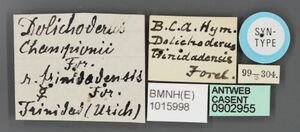
| |
| Syntype of Dolichoderus championi trinidadensis. Worker. Specimen code casent0902955. Photographer Will Ericson, uploaded by California Academy of Sciences. | Owned by NHMUK, London, UK. |
  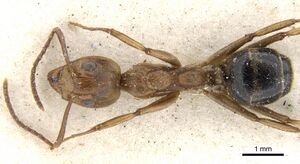 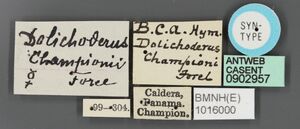
| |
| Syntype of Dolichoderus championi. Worker. Specimen code casent0902957. Photographer Will Ericson, uploaded by California Academy of Sciences. | Owned by NHMUK, London, UK. |
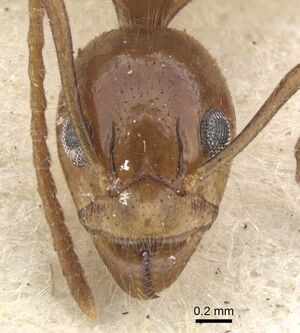 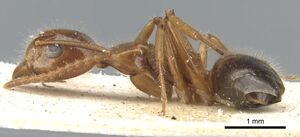  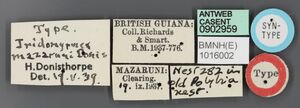
| |
| Syntype of Iridomyrmex mazaruni. Worker. Specimen code casent0902959. Photographer Will Ericson, uploaded by California Academy of Sciences. | Owned by NHMUK, London, UK. |
 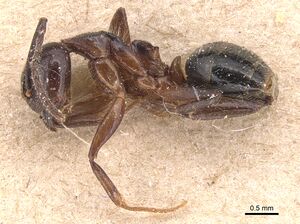 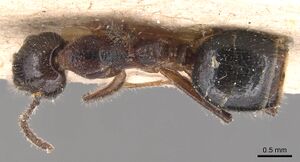 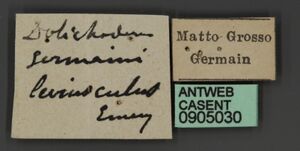
| |
| Syntype of Dolichoderus germaini leviusculus. Worker. Specimen code casent0905030. Photographer Will Ericson, uploaded by California Academy of Sciences. | Owned by MSNG, Genoa, Italy. |
 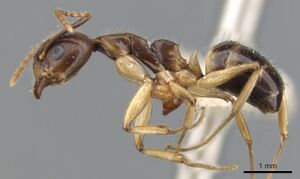   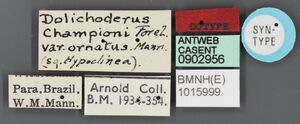
| |
| Syntype of Dolichoderus championi ornatus. Worker. Specimen code casent0902956. Photographer Will Ericson, uploaded by California Academy of Sciences. | Owned by NHMUK, London, UK. |
Queen
Images from AntWeb
   
| |
| Syntype of Iridomyrmex mazaruni. Queen (alate/dealate). Specimen code casent0902958. Photographer Will Ericson, uploaded by California Academy of Sciences. | Owned by NHMUK, London, UK. |
Nomenclature
The following information is derived from Barry Bolton's Online Catalogue of the Ants of the World.
- diversus. Dolichoderus (Hypoclinea) diversus Emery, 1894c: 237 (w.) COLOMBIA. Mackay, 1993b: 52 (q.m.) Combination in Hypoclinea: Kempf, 1972a: 119; in Dolichoderus: Shattuck, 1992c: 77. Senior synonym of championi, garbei, leviusculus, mazaruni, ornatus, taeniatus, trinidadensis: Mackay, 1993b: 50. See also: Shattuck, 1994: 48.
- championi. Dolichoderus championi Forel, 1899c: 100 (w.q.m.) MEXICO. Wheeler, G.C. & Wheeler, J. 1951: 175 (l.). Combination in D. (Hypoclinea): Emery, 1913a: 12; in Hypoclinea: Kempf, 1972a: 119; in Dolichoderus: Shattuck, 1992c: 77. Junior synonym of diversus: Mackay, 1993b: 50.
- trinidadensis. Dolichoderus championi r. trinidadensis Forel, 1899c: 100 (w.) TRINIDAD. Combination in D. (Hypoclinea): Emery, 1913a: 12; in Hypoclinea: Kempf, 1972a: 119; in Dolichoderus: Shattuck, 1992c: 77. Junior synonym of diversus: Mackay, 1993b: 50.
- leviusculus. Dolichoderus germaini subsp. leviusculus Emery, 1906c: 173 (w.) BRAZIL. Forel, 1909a: 260 (q.). Combination in Hypoclinea: Kempf, 1972a: 119; in Dolichoderus: Shattuck, 1992c: 77. Junior synonym of diversus: Mackay, 1993b: 50.
- garbei. Dolichoderus germaini subsp. garbei Forel, 1911c: 305 (w.) BRAZIL. Combination in Hypoclinea: Kempf, 1972a: 119; in Dolichoderus: Shattuck, 1992c: 77. Junior synonym of diversus: Mackay, 1993b: 50.
- ornatus. Dolichoderus (Hypoclinea) championi var. ornatus Mann, 1916: 466 (w.q.) BRAZIL. Combination in Hypoclinea: Kempf, 1972a: 119; in Dolichoderus: Shattuck, 1992c: 77. Junior synonym of diversus: Mackay, 1993b: 50.
- taeniatus. Dolichoderus (Hypoclinea) championi var. taeniatus Wheeler, W.M. 1916d: 329 (w.q.) COLOMBIA. [First available use of Dolichoderus championi r. trinidadensis var. taeniatus Forel, 1899c: 101; unavailable name.] Junior synonym of diversus: Mackay, 1993b: 50.
- mazaruni. Iridomyrmex mazaruni Donisthorpe, 1939c: 152 (w.q.) GUYANA. Combination in Dolichoderus: Shattuck, 1992c: 77. Junior synonym of diversus: Mackay, 1993b: 50.
Description
Karyotype
- See additional details at the Ant Chromosome Database.
 Explore: Show all Karyotype data or Search these data. See also a list of all data tables or learn how data is managed.
Explore: Show all Karyotype data or Search these data. See also a list of all data tables or learn how data is managed.
- 2n = 22, karyotype = 10M+12SM (Brazil) (Santos et al., 2016).
References
- Albuquerque, E., Prado, L., Andrade-Silva, J., Siqueira, E., Sampaio, K., Alves, D., Brandão, C., Andrade, P., Feitosa, R., Koch, E., Delabie, J., Fernandes, I., Baccaro, F., Souza, J., Almeida, R., Silva, R. 2021. Ants of the State of Pará, Brazil: a historical and comprehensive dataset of a key biodiversity hotspot in the Amazon Basin. Zootaxa 5001, 1–83 (doi:10.11646/zootaxa.5001.1.1).
- Cardoso Neto, J.A., Leal, L.C., Baccaro, F.B. 2019. Temporal and spatial gradients of humidity shape the occurrence and the behavioral manipulation of ants infected by entomopathogenic fungi in Central Amazon. Fungal Ecology 42, 100871 (doi:10.1016/j.funeco.2019.100871).
- Dubovikoff, D.A., Cornado-Blanco, J.M. 2017. A review of the ant genus Dolichoderus Lund, 1831 (Hymenoptera, Formicidae: Dolichoderinae) of Mexico. Entomological Review 97: 1321-1331.
- Emery, C. 1894d. Studi sulle formiche della fauna neotropica. VI-XVI. Bull. Soc. Entomol. Ital. 26: 137-241 (page 237, worker described)
- Franco, W., Ladino, N., Delabie, J.H.C., Dejean, A., Orivel, J., Fichaux, M., Groc, S., Leponce, M., Feitosa, R.M. 2019. First checklist of the ants (Hymenoptera: Formicidae) of French Guiana. Zootaxa 4674, 509–543 (doi:10.11646/zootaxa.4674.5.2).
- Hsu, F.-C., Tseng, S.-P., Hsu, P.-W., Lu, C.-W., Yang, C.-C.S., Lin, C.-C. 2022. Introduction of a non-native lineage is linked to the recent black cocoa ant, Dolichoderus thoracicus (Smith, 1860), outbreaks in Taiwan. Taiwania 67: 271‒279 (doi:10.6165/tai.2022.67.271).
- Kempf, W. W. 1972b. Catálogo abreviado das formigas da regia~o Neotropical. Stud. Entomol. 15: 3-344 (page 119, Combination in Hypoclinea)
- Mackay, W. P. 1993b. A review of the New World ants of the genus Dolichoderus (Hymenoptera: Formicidae). Sociobiology 22: 1-148 (page 50, Senior synonym of championi, garbei, leviusculus, mazaruni, ornatus, taeniatus and trinidadensis)
- Mackay, W. P. 1993b. A review of the New World ants of the genus Dolichoderus (Hymenoptera: Formicidae). Sociobiology 22: 1-148 (page 52, queen, male described)
- Santos, I.S., Mariano, C.S.F., Delabie, J.H.C., Costa, M.A., Carvalho, A.F., Silva, J.G. 2016. "Much more than a neck": karyotype differentiation between Dolichoderus attelaboides (FABRICIUS, 1775) and Dolichoderus decollatus F. SMITH, 1858 (Hymenoptera: Formicidae) and karyotypic diversity of five other Neotropical species of Dolichoderus LUND, 1831. Myrmecological News 23: 61-69.
- Shattuck, S. O. 1992c. Generic revision of the ant subfamily Dolichoderinae (Hymenoptera: Formicidae). Sociobiology 21: 1-181 (page 77, Combination in Dolichoderus)
- Shattuck, S. O. 1994. Taxonomic catalog of the ant subfamilies Aneuretinae and Dolichoderinae (Hymenoptera: Formicidae). Univ. Calif. Publ. Entomol. 112:i-xix, 1-241. (page 48, see also)
- Ulysséa, M.A., Brandão, C.R.F. 2013. Ant species (Hymenoptera, Formicidae) from the seasonally dry tropical forest of northeastern Brazil: a compilation from field surveys in Bahia and literature records. Revista Brasileira de Entomologia 57, 217–224 (doi:10.1590/s0085-56262013005000002).
References based on Global Ant Biodiversity Informatics
- Baroni Urbani C. 1977. Katalog der Typen von Formicidae (Hymenoptera) der Sammlung des Naturhistorischen Museums Basel (2. Teil). Mitt. Entomol. Ges. Basel (n.s.) 27: 61-102.
- Bluthgen N., M. Verhaagh, W. Goitia, K. Jaffe, W. Morawetz, and W. Barthlott. 2000. How plants shape the ant community in the Amazonian rainforest canopy: the key role of extrafloral nectaries and homopteran honeydew. Oecologia 125: 229-240.
- Borgmeier T. 1923. Catalogo systematico e synonymico das formigas do Brasil. 1 parte. Subfam. Dorylinae, Cerapachyinae, Ponerinae, Dolichoderinae. Archivos do Museu Nacional (Rio de Janeiro) 24: 33-103.
- Brandao, C.R.F. 1991. Adendos ao catalogo abreviado das formigas da regiao neotropical (Hymenoptera: Formicidae). Rev. Bras. Entomol. 35: 319-412.
- Dattilo W. et al. 2019. MEXICO ANTS: incidence and abundance along the Nearctic-Neotropical interface. Ecology https://doi.org/10.1002/ecy.2944
- Dejean A., and I. Olmsted. 1997. Ecological studies on Aechmea bracteata (Swartz)(Bromeliaceae). Journal of Natural History 31: 1313-1334.
- Dejean, A., S. Durou, I. Olmsted, R.R. Snelling and J. Orivel. 2003. Nest Site Selection by Ants in a Flooded Mexican Mangrove, with Special Reference to the Epiphytic Orchid Myrmecophila christinae. Journal of Tropical Ecology 19(3) :325-331
- Dejean, A., S. Durou, I. Olmsted, R.R. Snelling and J. Orivel. 2003. Nest Site Selection by Ants in a Flooded Mexican Mangrove, with Special Reference to the Epiphytic Orchid Myrmecophila christinae. Journal of Tropical Ecology 19(3):325-331
- Donisthorpe H. 1939. Descriptions of several species of ants (Hymenopt.) taken by Dr. O. W. Richards in British Guiana. Proceedings of the Royal Entomological Society of London. Series B 8: 152-154.
- Emery C. 1906. Studi sulle formiche della fauna neotropica. XXVI. Bullettino della Società Entomologica Italiana 37: 107-194.
- Emery C. 1913. Hymenoptera. Fam. Formicidae. Subfam. Dolichoderinae. Genera Insectorum 137: 1-50.
- Escalante Gutiérrez J. A. 1993. Especies de hormigas conocidas del Perú (Hymenoptera: Formicidae). Revista Peruana de Entomología 34:1-13.
- Forel A. 1909. Ameisen aus Guatemala usw., Paraguay und Argentinien (Hym.). Deutsche Entomologische Zeitschrift 1909: 239-269.
- Forel A. 1912. Formicides néotropiques. Part V. 4me sous-famille Dolichoderinae Forel. Mémoires de la Société Entomologique de Belgique. 20: 33-58.
- Franco W., N. Ladino, J. H. C. Delabie, A. Dejean, J. Orivel, M. Fichaux, S. Groc, M. Leponce, and R. M. Feitosa. 2019. First checklist of the ants (Hymenoptera: Formicidae) of French Guiana. Zootaxa 4674(5): 509-543.
- Gomes E. C. F., G. T. Ribeiro, T. M. S. Souza, and L. Sousa-Souto. 2014. Ant assemblages (Hymenoptera: Formicidae) in three different stages of forest regeneration in a fragment of Atlantic Forest in Sergipe, Brazil. Sociobiology 61(3): 250-257.
- Kempf W. W. 1978. A preliminary zoogeographical analysis of a regional ant fauna in Latin America. 114. Studia Entomologica 20: 43-62.
- Kempf, W.W. 1972. Catalago abreviado das formigas da regiao Neotropical (Hym. Formicidae) Studia Entomologica 15(1-4).
- Kusnezov N. 1953. La fauna mirmecológica de Bolivia. Folia Universitaria. Cochabamba 6: 211-229.
- Longino, J.T. 2010. Personal Communication. Longino Collection Database
- Mackay, W.P. 1993. A review of the New World ants of the genus Dolichoderus (Hymenoptera: Formicidae). Sociobiology 22(1):1-148
- Maes, J.-M. and W.P. MacKay. 1993. Catalogo de las hormigas (Hymenoptera: Formicidae) de Nicaragua. Revista Nicaraguense de Entomologia 23.
- Mann W. M. 1916. The Stanford Expedition to Brazil, 1911, John C. Branner, Director. The ants of Brazil. Bulletin of the Museum of Comparative Zoology 60: 399-490
- Neves F. S., K. S. Queiroz-Dantas, W. D. da Rocha, and J. H. C. Delabie. 2013. Ants of Three Adjacent Habitats of a Transition Region Between the Cerrado and Caatinga Biomes: The Effects of Heterogeneity and Variation in Canopy Cover. Neotrop Entomol 42: 258268.
- Pires de Prado L., R. M. Feitosa, S. Pinzon Triana, J. A. Munoz Gutierrez, G. X. Rousseau, R. Alves Silva, G. M. Siqueira, C. L. Caldas dos Santos, F. Veras Silva, T. Sanches Ranzani da Silva, A. Casadei-Ferreira, R. Rosa da Silva, and J. Andrade-Silva. 2019. An overview of the ant fauna (Hymenoptera: Formicidae) of the state of Maranhao, Brazil. Pap. Avulsos Zool. 59: e20195938.
- Reis P. C. J., W. D. Darocha, L. Falcao, T. J. Guerra, and F. S. Neves. 2013. Ant Fauna on Cecropia pachystachya Trécul (Urticaceae) Trees in an Atlantic Forest Area, Southeastern Brazil. Sociobiology 60(3): 222-228.
- Ryder Wilkie K.T., A. L. Mertl, and J. F. A. Traniello. 2010. Species Diversity and Distribution Patterns of the Ants of Amazonian Ecuador. PLoS ONE 5(10): e13146.doi:10.1371/journal.pone.0013146
- Shattuck S. O. 1994. Taxonomic catalog of the ant subfamilies Aneuretinae and Dolichoderinae (Hymenoptera: Formicidae). University of California Publications in Entomology 112: i-xix, 1-241.
- Silva F. H. O., J. H. C. Delabie, G. B. dos Santos, E. Meurer, and M. I. Marques. 2013. Mini-Winkler Extractor and Pitfall Trap as Complementary Methods to Sample Formicidae. Neotrop Entomol 42: 351358.
- Vásquez-Bolaños M. 2011. Lista de especies de hormigas (Hymenoptera: Formicidae) para México. Dugesiana 18: 95-133
- Wheeler W. M. 1907. A collection of ants from British Honduras. Bulletin of the American Museum of Natural History 23: 271-277.
- Wheeler W. M. 1922. The ants of Trinidad. American Museum Novitates 45: 1-16.
- Wheeler W. M. 1942. Studies of Neotropical ant-plants and their ants. Bulletin of the Museum of Comparative Zoology 90: 1-262.
- Wheeler, William Morton. 1916. Ants Collected in Trinidad by Professor Roland Thaxter, Mr. F. W. Urich, and Others. Bulletin of the Museum of Comparitive Zoology at Harvard University. 40(8):322-330
- Wilson, E.O. 1987. The Arboreal Ant Fauna of Peruvian Amazon Forests: A First Assessment. Biotropica 19(3):245-251.
- da Silva de Oliveira A. B., and F. A. Schmidt. 2019. Ant assemblages of Brazil nut trees Bertholletia excelsa in forest and pasture habitats in the Southwestern Brazilian Amazon. Biodiversity and Conservation 28(2): 329-344.

